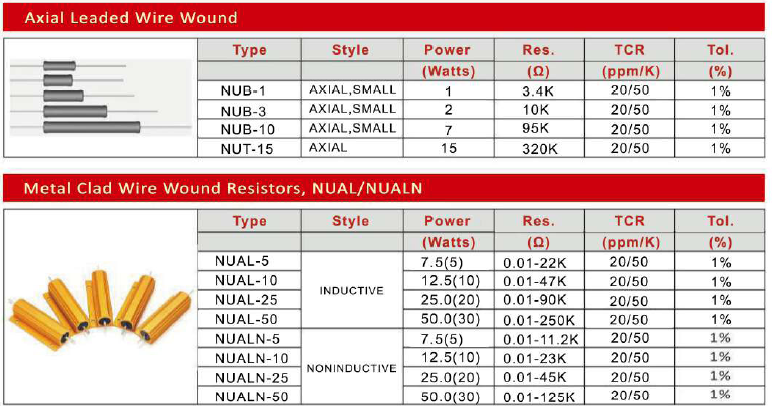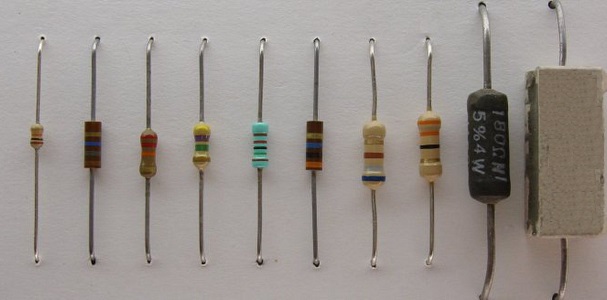Position:Home » Technical Articles
Single through-hole resistors' characteristics and installation
Writer:Microhm Page View:Date:2020-01-23
Wirewound and axial packages are the two types of through-hole resistors, with axial packaging representing the most commonly used. This resistor size is based on its power rating. The axial leads are at each end of the cylinder or box-shaped component. They are used for short distances and they have a low or flat profile on the board. Wirewound resistors are usually more expensive, higher-end components used based on their higher power rating or inherent maximum temperature range. Wirewound resistors and axial resistors are important part of Microhm Electronics' product lineup.

Through-hole mounting uses leads that are inserted into holes drilled on PCBs and are then soldered to pads on the other side of the board by automated insertion machines or by hand placement. The resistors used are plated through-hole (PTH) with long, pliable leads that are either hand-soldered onto a board or inserted into a breadboard. The leads, once placed, are then trimmed. These resistors are made from carbon, metal, or metal-oxide film. Through-hole technology are fit for high-power or high-voltage applications. These resistors feature low cost, high performance and a wide range of resistance values. Some typical examples of them are Microhm Electronics' EE series, NUB series and HPMRY series.
Wirewound resistors have a metal wire wound around a ceramic, plastic, or fiberglass core. The wire ends are soldered or welded to caps at the ends of the core and the resistor assembly is covered with a layer of enamel or paint for protection. The most typical one is the metal clad wirewound resistor, and NUAL series is the model for Microhm Electronics.

Through-hole mounting provides strong mechanical bonds, but the drilling required makes the boards more expensive to produce. When using multi-layered boards, they also limit the available routing area for signal traces below the top layer since the holes need to go through all layers. As a result, through-hole mounting is usually reserved for bulkier or heavier components or those that require great strength in support such as plug connectors.

Through-hole mounting uses leads that are inserted into holes drilled on PCBs and are then soldered to pads on the other side of the board by automated insertion machines or by hand placement. The resistors used are plated through-hole (PTH) with long, pliable leads that are either hand-soldered onto a board or inserted into a breadboard. The leads, once placed, are then trimmed. These resistors are made from carbon, metal, or metal-oxide film. Through-hole technology are fit for high-power or high-voltage applications. These resistors feature low cost, high performance and a wide range of resistance values. Some typical examples of them are Microhm Electronics' EE series, NUB series and HPMRY series.
Wirewound resistors have a metal wire wound around a ceramic, plastic, or fiberglass core. The wire ends are soldered or welded to caps at the ends of the core and the resistor assembly is covered with a layer of enamel or paint for protection. The most typical one is the metal clad wirewound resistor, and NUAL series is the model for Microhm Electronics.

Through-hole mounting provides strong mechanical bonds, but the drilling required makes the boards more expensive to produce. When using multi-layered boards, they also limit the available routing area for signal traces below the top layer since the holes need to go through all layers. As a result, through-hole mounting is usually reserved for bulkier or heavier components or those that require great strength in support such as plug connectors.
Latest News
- Resistor's role in measuring and correcting LED,,,
- Single through-hole resistors' characteristics ,,,
- Why shunt resistors for current sense applicati,,,
- Metal-film resistors with small size, high resi,,,
- 36W High-Current Shunt Resistors MMS8420,,,
- 1W Surface Mount Resistor MPR1206,,,
- An Overview of Microhm Electronics' Resistor Pr,,,
- More anti-sulfur resistors used in harsh envir,,,
- Resistance changes with temperature,,,
- 140W TO247 High Power Heatsinkable Resistor,,,
- MMS5930 is ideal for current sensing in industr,,,
- Shunt resistors selection for engineers' design,,,
- Considerations for choosing precision resistors,,,
- Ceramic Encased Cement Resistors NWH Series for,,,
- Resistors for Passive Balancing in Battery-Pow,,,
Hot Articles
- Microhm will take part in 10th Automotive World,,,
- Thanks for Visiting Microhm's Booth E5-5706 in ,,,
- Resistors in Short Supply: Blame Cars,,,
- New lunch: High Power Precision Shunt Resistor,,,,
- How to Test a Resistor,,,
- Innovative Technology, Future Electric: Electri,,,
- What is Precision Resistors?,,,
- SMD Resistors Sizes and Packages,,,
- The Construction and Features of Metal Film Res,,,
- What is a TO-220 Resisor?,,,
- Hot Selling Products: Precision Shunt Resistors,,,
- How to Calculate the Equivalent Resistance Valu,,,
- What is a Fixed Resistor?,,,
- Resistors in LED Circuits,,,
- Resistors Types and Materials Overview,,,
Resistance applications
- Miniature future for passive electronic compone,,,
- Why Zero-Ohm Resistors?,,,
- Shunt Resistor MMS8420 for High Current Stable ,,,
- The Main Application for High Precision and Low,,,
- Industrial Roberts Applied to Solar Photovoltai,,,
- Urbanization Development Bringing the Transform,,,
- BMS for New Energy Vehicle,,,
- Heater Blower Motor Resistor in Air Conditioner,,,
- The Four Important Functions of Alloy Resistors,,,
- Surface Mount Resistor's Size and Package ,,,
- Difference Between High Precision Resistors and,,,
- Carbon Film Resistors' Features and Application,,,
- The Measurement Accuracy of Automotive Shunt is,,,
- Select the Right Resistor for Harmonic Filterin,,,
- Precision Resistors' Construction and TCR,,,
